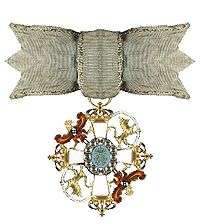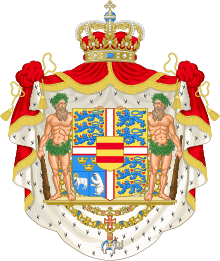Sophie Magdalene of Brandenburg-Kulmbach
| Sophie Magdalene of Brandenburg-Kulmbach | |
|---|---|
 | |
| Queen consort of Denmark and Norway | |
| Tenure | 1730–1746 |
| Born |
28 November 1700 Castle Schonberg |
| Died |
27 May 1770 (aged 69) Christiansborg Palace |
| Burial | Roskilde Cathedral |
| Spouse | Christian VI of Denmark |
| Issue |
Frederick V of Denmark Louise, Duchess of Saxe-Hildburghausen |
| House | House of Hohenzollern |
| Father | Christian Heinrich, Margrave of Brandenburg-Bayreuth-Kulmbach |
| Mother | Sophie Christiane of Wolfstein |
| Religion | Lutheranism |
Sophie Magdalene of Brandenburg-Kulmbach (28 November 1700 – 27 May 1770) was queen-consort of Denmark and Norway as the wife of King Christian VI of Denmark and Norway.
Early life
She was born in Castle Schonberg, to Christian Heinrich, Margrave of Brandenburg-Bayreuth-Kulmbach by his wife, Countess Sophie Christiane of Wolfstein. She was raised at the court of the Queen of Poland, Christiane Eberhardine of Brandenburg-Bayreuth, in Saxony.
Marriage
King Frederick IV of Denmark allowed his son, Crown Prince Christian, to find a suitable bride. During a trip through Europe accompanied by Chancellor Ulrik Adolf Holstein the Crown Prince meet Sophie Magdalene while she was serving as lady-in-waiting of the Queen of Poland at the Pretzsch Castle. She came from a small (the Margraviate of Kulmbach was not greater than Lolland-Falster), insignificant, relatively poor and large German princely family (she had 13 siblings); however, the King gave his permission. In the Crown Prince's letters he wrote that he fell for the Sophie Magdalene's intense religiosity, which matched with his own beliefs. It would affect his later reign. The wedding took place on 7 August 1721 at Pretzsch Castle in Saxony.
A French envoy to the Danish court sent a description home of the 20-year-old Crown Princess:
- ...She's a proud, impressive woman, although she is not high growth or of beautiful forms. She's not exactly pretty, but her majestic attitude was notorious. Her skin is very white, her face-range is fine, vibrant and soulful with light blue eyes; they still shaped lips crimped sometimes of a sneer. She dressed with the greatest splendor and used a lot of diamonds and other precious stones.[1]
About the Crown Prince, the French diplomat made one unflattering description:
- ... He's a small, frail, sickly-looking gentleman. His face is elongated, pale, somewhat haggard, his nose is very big. The eyes are very prominent and mouth pulled up in a forced, stereotyped smile".
Family and religion
Sophie Magdalene's religiosity and strong influence of Pietism was expressed when in 1737 she founded at Vallø Castle the Noble Vallø Foundation for Unmarried Daughters (Danish: Det Adelige Stift Vallø for ugifte døtre), a home for aging and aristocratic unmarried ladies. She never forgot that she came from a poor noble family, and always supported her siblings. As a queen, she received several of her relatives in Denmark. Her younger sister, Sophie Caroline, Dowager Princess of Ostfriesland, was appointed by her as abbess at Vallø, with an annual pension of 16,600 thalers,[2] a large sum in those times.
At the National Archives was store a letter from Sophie Magdalene to her husband. She asked him to allow the return of her sister to Ostfriesland. The reason was that the queen was violently jealous of her, and was sure that Sophie Caroline and Christian VI had an affair. The king replied "that he with all his heart was willing to let her go, if with this he could win his wife's confidence and heart, but it would hurt the Princess".[3] At end, Sophie Caroline was not expelled.
Two of Sophie Magdalene's brothers were Danish admirals, and her mother, Dowager Margravine Sophie Christiane of Brandenburg-Kulmbach, arrived to Denmark after the announcement of Sophie Magdalene's first pregnancy in 1723, staying at Sorgenfri Palace in Kongens Lyngby, where she remained for the rest of her life.[3]
Sophie Magdalene and her grandson, the later King Christian VII, had a warm and close relationship. He could find at the side of his grandmother a loving refuge from his strict overhofmester, Ditlev Reventlow. Christian and his cousin, Prince Charles of Hesse-Kassel, spent much time with Sophie Magdalene at Hirschholm Palace, much to Reventlow's regret; he complained that the crown prince "was so spoiled by Sophie Magdalene during his days with her that he became a boy again".[4] In addition, Sophie Magdalene also hosted almost all Christian's birthdays celebrations.[5]
For Sophie Magdalene was source of great concern and disappointment that none of her two surviving children inherited the strict ideals and lifestyle of their parents. King Frederick V was known in history as a notorious drunkard with sadistic tendencies, while Princess Louise reportedly became pregnant by a Valet de chambre, a scandal that caused her to be hastily married with the Duke of Saxe-Hildburghausen, who received a large dowry in compensation.
Sophie Magdalene was distantly related with King Christian VII's mistress, Anne Cathrine Benthagen, the famous Støvlet-Cathrine, who reportedly was the illegitimate daughter of Prince Georg Ludwig of Brunswick-Bevern, whose sister was married with one of the queen's brothers.[6]
Unpopular Queenship
Despite their Pietism, the royal couple loved the splendor and luxury; King Louis XIV of France was their great princely role model. It has been speculated that the love of Sophie Magdalene for the jewels and luxury came from her father-in-law, after watching him covered his consort, Anna Sophie Reventlow (who was detested by the Crown Princess), with jewels and other gifts.
Sophie Magdalene led an extravagant lifestyle - despite Denmark's faltering economy.[7]
When Frederick IV died in 1730, Christian VI and Sophie Magdalene were crowned King and Queen of Denmark and Norway. She was behind the making of a new Danish queen's crown when she refused to wear the same one that the hated Queen Anna Sophie –whom she called "that whore!" (die Hure!)[2]– had worn. Queen Sophie Magdelene established the collection of crown jewels when she bequeathed a large part of her jewellery for that purpose. This includes the emeralds given to Sophie by King Christian VI upon the birth of the future Frederik V.[8]
 | |
|
|
The royal couple's life together was harmonious and her spouse respected and trusted her, but they weren't unpopular. Sophie Magdalene was accused of creating a certain closedness around the Court and the royal family. She was seen as haughty, arrogant and proud. Her background in a religious environment, marked by Pietism, strongly influenced the introduction of the subdued life at the Court. However, although her court was strict, it was also very luxurious. Sophie Magdalene, following the fashion of queens of her day, owned a lathe built by Diderich de Thurah, 1735–36, which she used for turning items of ivory or precious woods. She was interested in luxury, pomp, fashion and jewelry and spent large sums of money on luxury during a time of poverty in the country. She made the most of her position as Queen in etiquette and ceremonial matters. In addition, the royal couple established several laws and prohibitions, including against rides on Sundays, and in 1735 introduced public holiday regulation with obligatory church attendance, where breaches of duty resulted in fines or time in jail. At the same time they let themselves rarely see in public, and was so humanly hostile that they let themselves be transported through the city in a carriage with covered windows.
Later, she was criticized also for never having discarded her German, even though German culture and language had been dominant at the Court before her time. Her German entourage was given important positions at court and was favoured over Danes; her brothers were outranked "Princes of the Blood," and her German ladies-in-waiting got the rank over all the countesses of the Kingdom.[3]
The Queen learned Danish, but German was the language spoken at court and in high society.[7] The first member of the Danish royal family who spoke Danish rather than German was Sophie Magdalene's great grandson, Frederik VI, who became King in 1808. Her dislike for all Danish was so pronounced that when she once visited Valløs noble monastery, where lived a majority of German women, she cried on the way into the room of the Danish Miss Rosenkrantz and reportedly said: "It smells so Danish!" (Es riecht hier so dänisch!).[9]
L'Union parfaite

In 1732, she founded the order Ordre de l'Union Parfaite, which was to be given only to women who lived in happy marriages. The royal couple's marriage was rooted in genuine infatuation and love.
The Order was the first Danish order which had to be carried by women.
Later life
.jpg)
As a queen dowager, she lived a discreet life under the reign of her son, with whom she was too different in character to get along. She disliked his favourite, Moltke, whom she blamed for the distance between them.
She had Hirschholm Palace built and lived there after being widowed in 1746.
During the reign of her grandson, she got more attention, as she was on much better terms with her grandchildren than with her children. Crown Prince Christian and his cousin, Prince Charles of Hesse-Kassel, spent much time with the queen on Hirschholm. During Christian's visits to her as a child, she spoilt him so much that he was considered impossible to deal with and more rebellious than ever. During Christian's reign, Moltke was disfavoured and Danneskjöld was favoured on her advice. She spent her later years in bad health, or, as it was said, in hypochondria.
She died in Christiansborg Palace and was buried in Roskilde Cathedral.

Children
- Frederick V of Denmark (31 March 1723 – 14 January 1766).
- Princess Louise (19 June 1724 – 20 December 1724).
- Princess Louise (19 October 1726 – 8 August 1756), married Ernest Frederick III, Duke of Saxe-Hildburghausen.
Ancestry
| Ancestors of Sophie Magdalene of Brandenburg-Kulmbach | ||||||||||||||||||||||||||||||||||||||||||||||||||||||||||||||||||||||||||||||||||||||||||||||||||||||||||||||||||||||||||||||||||||||||||||||||||||||||||||||||||||||||||||||||||||||||||||||||||||||||||||||||||||||||||||||||||||||||||||||||||||||||||||||||||||||||||||||||||||||||||||||||||||||||||||||||||||||||||||||||||||||||||||||||||||||||||||||||||||||||||||||||||||||||||||||||||||||||||||||||||||||||||||||||||||||||||||||||||||||||||||||||||||||||||||||||||||||||||||||||||||||||||||||||||||||||||||||||||
|---|---|---|---|---|---|---|---|---|---|---|---|---|---|---|---|---|---|---|---|---|---|---|---|---|---|---|---|---|---|---|---|---|---|---|---|---|---|---|---|---|---|---|---|---|---|---|---|---|---|---|---|---|---|---|---|---|---|---|---|---|---|---|---|---|---|---|---|---|---|---|---|---|---|---|---|---|---|---|---|---|---|---|---|---|---|---|---|---|---|---|---|---|---|---|---|---|---|---|---|---|---|---|---|---|---|---|---|---|---|---|---|---|---|---|---|---|---|---|---|---|---|---|---|---|---|---|---|---|---|---|---|---|---|---|---|---|---|---|---|---|---|---|---|---|---|---|---|---|---|---|---|---|---|---|---|---|---|---|---|---|---|---|---|---|---|---|---|---|---|---|---|---|---|---|---|---|---|---|---|---|---|---|---|---|---|---|---|---|---|---|---|---|---|---|---|---|---|---|---|---|---|---|---|---|---|---|---|---|---|---|---|---|---|---|---|---|---|---|---|---|---|---|---|---|---|---|---|---|---|---|---|---|---|---|---|---|---|---|---|---|---|---|---|---|---|---|---|---|---|---|---|---|---|---|---|---|---|---|---|---|---|---|---|---|---|---|---|---|---|---|---|---|---|---|---|---|---|---|---|---|---|---|---|---|---|---|---|---|---|---|---|---|---|---|---|---|---|---|---|---|---|---|---|---|---|---|---|---|---|---|---|---|---|---|---|---|---|---|---|---|---|---|---|---|---|---|---|---|---|---|---|---|---|---|---|---|---|---|---|---|---|---|---|---|---|---|---|---|---|---|---|---|---|---|---|---|---|---|---|---|---|---|---|---|---|---|---|---|---|---|---|---|---|---|---|---|---|---|---|---|---|---|---|---|---|---|---|---|---|---|---|---|---|---|---|---|---|---|---|---|---|---|---|---|---|---|---|---|---|---|---|---|---|---|---|---|---|---|---|---|---|---|---|---|---|---|---|---|---|---|---|---|---|---|---|---|---|---|---|---|---|---|---|---|---|---|---|---|---|---|---|---|---|---|---|---|---|---|---|---|---|---|---|---|---|---|---|---|---|---|---|---|---|---|---|---|---|---|---|---|---|---|---|---|---|---|---|---|---|---|---|---|---|---|---|---|---|---|---|---|---|---|---|---|---|---|---|---|---|---|---|---|---|---|
| ||||||||||||||||||||||||||||||||||||||||||||||||||||||||||||||||||||||||||||||||||||||||||||||||||||||||||||||||||||||||||||||||||||||||||||||||||||||||||||||||||||||||||||||||||||||||||||||||||||||||||||||||||||||||||||||||||||||||||||||||||||||||||||||||||||||||||||||||||||||||||||||||||||||||||||||||||||||||||||||||||||||||||||||||||||||||||||||||||||||||||||||||||||||||||||||||||||||||||||||||||||||||||||||||||||||||||||||||||||||||||||||||||||||||||||||||||||||||||||||||||||||||||||||||||||||||||||||||||
References
- ↑ Ellen B. Danstrup: Christian 6., Sophie Magdalene og Norgesrejsen 1733, 1989, p. 12.
- 1 2 Signe Prytz: Sorgenfri Slot, 1979, p. 31.
- 1 2 3 Signe Prytz: Sorgenfri Slot, 1979.
- ↑ Overhofmarskallatet: Dagjournaler, 14 January. forskellige år; Biehl 1901, pp. 6–7.
- ↑ Ulrik Langen: Den Afmægtige, 2008.
- ↑ Ulrik Langen: Den Afmægtige, 2008, p. 210.
- 1 2 Salmonsen, p. 881.
- ↑ "The Danish Emerald Parure Tiara". Order of Splendor.
- ↑ Joh. Nordahl-Olsen: Ludvig Holberg i Bergen (pp. 17–18), John Griegs forlag, Bergen 1905.
- (Danish) Article in the Dansk biografisk Lexikon
- Biography
- Damstrup, Ellen B., Christian 6., Sophie Magdalene og Norgesrejsen 1733 , 1989
- Dehn-Nielsen, Henning, Christian 7. – den gale konge, 2000
- Dehn-Nielsen, Henning, Danmarks Konger og Regenter, 1996
- Langen, Ulrik, Den Afmægtige – en biografi om Christian 7., 2008
- Langer, Jerk W., Kongehusets sygdomme – fra Gorm den Gamle til dronning Margrethe, 1997
- Nielsen, Kay m.f., Danmarks Konger og Dronninger
- Tillyard, Stella, En Kongelig Affære – Caroline Matilde og hendes søskende, 2007 (original English edition 2006)
External links
| Wikimedia Commons has media related to Sophia Magdalene of Brandenburg-Kulmbach. |
- Queen Sophie Magdalene at the website of the Royal Danish Collection at Rosenborg Castle
| Sophie Magdalene of Brandenburg-Kulmbach Born: 28 November 1700 Died: 27 May 1770 | ||
| Danish royalty | ||
|---|---|---|
| Preceded by Anne Sophie Reventlow |
Queen consort of Denmark and Norway 1730–1746 |
Succeeded by Louise of Great Britain |
